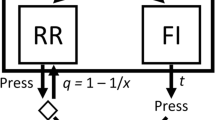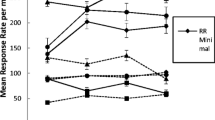Abstract
In an IRT >15-s schedule, either the number of points was fixed or a lesser number was awarded the later a response occu rred during the 5-s LH. As an additional means for enhancing feedback about performance, a response that exceeded the LH yielded minimal reward (vs. no reinforcer and clock reset), thus allowing differentiation between excessively long IRTs and anticipatory responses. It was expected that the “graded” scale of reward magnitude, coupled with delivery of one point for exceeding the LH, would increase precision of performance. Providing a point for overestimations did increase the percentage of IRTs falling within the LH, and graded magnitude of reward did enhance the proportion of IRTs taking place earlier within the LH. It was suggested that contingent incentive value, as incorporated in the present laboratory paradigms, effectively influenced performance and, in general, represents the nature of contingencies that prevail in the “real world.”
Similar content being viewed by others
References
BONEM, M., & CROSSMAN, E. K. (1988). Elucidating the effects of reinforcement magnitude. Psychological Bulletin, 104, 348–362.
BUSKIST, W., OLIVEIRA-CASTRO, J., & BENNETT, R. (1988). Some effects of response-correlated increases in reinforcer magnitude on human behavior. Journal of the Experimental Analysis of Behavior, 49, 87–94.
DAVEY, G. (1981). Animal learning and conditioning. Baltimore: University Park Press.
LINDSLEY, O. R. (1962). A behavioral measure of television viewing. Journal of Advertising Research, 2, 2–12.
LIPPMAN, L. G. (1973). Contingent magnitude of reward in human fixed-interval performance. Proceedings, 81st Annual Convention, Apa, 8, 867–868. (Summary)
LIPPMAN, L. G. (1977). Approximating “real-world” contingencies in the human operant laboratory. Journal of Biological Psychology, 19, 11–19.
LIPPMAN, L. G. (2000). Contingent incentive value in human operant performance. The Psychological Record, 50, 513–528.
LIPPMAN, L. G., LEANDER, J. D., & MEYER, M. E. (1970). Human fixed interval performance as related to response effortfulness and to initial point. Journal of General Psychology, 82, 57–61.
LOGAN, F. A. (1966). Continuously negatively correlated amount of reward. Journal of Comparative and Physiological Psychology, 62, 31–34.
LOVITT, T. C., & ESVELDT, K. A. (1970). The relative effects on math performance of simple- versus multiple-ratio schedules: A case study. Journal of Applied Behavior Analysis, 3, 261–270.
WEARDEN, J. H. (1988). Some neglected problems in the analysis of human operant behavior. In G. Davey & C. Cullen (Eds.), Human operant conditioning and behavior modification. New York: Wiley.
Author information
Authors and Affiliations
Corresponding author
Additional information
Kristine Bennington’s assistance with data entry is gratefully acknowledged. A version of this report was presented at the 26th annual convention of ABA, May 26–30, 2000, inWashington DC.
Rights and permissions
About this article
Cite this article
Lippman, L.G., Leritz, L.E. Contingent Magnitude of Reward in a Human Operant IRT >15-S-LH Schedule. Psychol Rec 52, 89–98 (2002). https://doi.org/10.1007/BF03395416
Published:
Issue Date:
DOI: https://doi.org/10.1007/BF03395416




